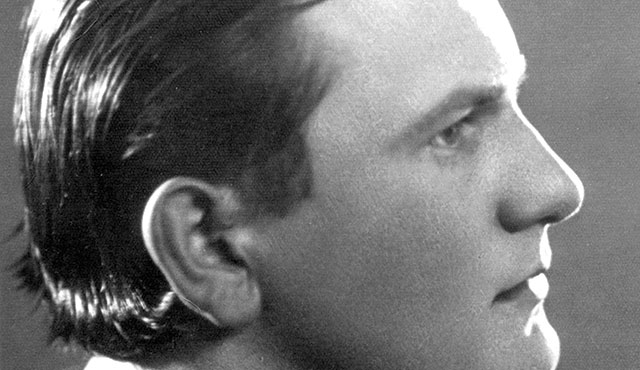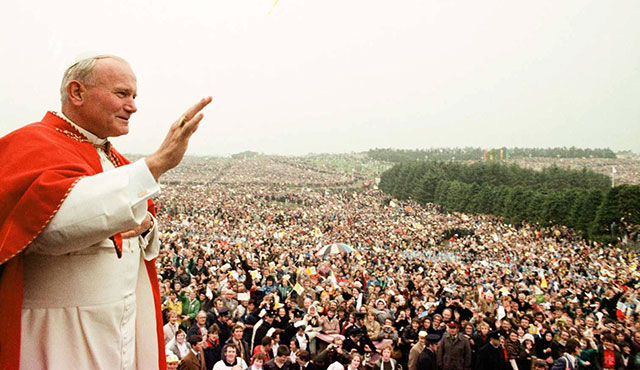Over this, your white grave
the flowers of life in white–
so many years without you–
how many have passed out of sight?
Over this your white grave
covered for years, there is a stir
in the air, something uplifting
and, like death, beyond comprehension.
Over this your white grave
oh, mother, can such loving cease?
for all his filial adoration
a prayer:
Give her eternal peace—
The poet who composed “Over This, Your White Grave” was not yet 19. His name was Karol Wojtyla. He would be destined to become Christ’s vicar on Earth and a future saint. But these accomplishments were not for vainglory. Suffering, the Cross, followed Karol Wojtyla his whole life. In this poem, we see a precious insight into his Polish heart: a lamentation for his beloved, deceased mother, Emilia. Emilia died when Karol was 9 years old, 10 years earlier. But like Jesus evoking Psalm 22 on the Cross, the lamentation becomes a prayer. “Give her eternal peace.”
Karol continued to write poetry over the years. As archbishop of Krakow, he published poetry under a pseudonym, “Andrzej Jawien.” But as pope, John Paul II only wrote and published one work of poetry in the 27 years of his pontificate.
“Roman Triptych,” a compilation of three poems, was released to the public in March 2003, when John Paul II was nearly 83. The subject matter of the Pope’s poetic meditations was none other than Michelangelo’s artwork in the Sistine Chapel.
“Meditations on the Book of Genesis at the Threshold of the Sistine Chapel” is the title of the second poem. One can imagine Pope John Paul II, alone in the Sistine Chapel, gazing up at the awesome depictions of God’s Revelation, praying and writing.
“I stand at the entrance of the Sistine,” he writes…
But the Book awaits the image—
And rightly so. It was waiting for its Michelangelo.
The One who created “saw”—saw that “it was good”.
“He saw”, and so the Book awaited the fruit of “vision”.
O all you who see, come—
I am calling you, all “beholders” in every age.
I am calling you, Michelangelo!
In the language of someone who freely embraces whenever it is time to be called to the Father’s house, the Pope connects Michelangelo’s works from Genesis with the last things, as seen in “The Last Judgment”:
It is the Book of the origins—Genesis.
Here, in this chapel, Michelangelo penned it,
not with words, but with the richness
of piled-up colours.
We enter in order to read it again,
going from wonder to wonder.
So then, it is here—we look and recognize
the Beginning which emerged out of nothingness,
obedient to the creative Word.
Here it speaks from these walls.
But still more powerfully the End speaks.
Yes, the judgment is even more outspoken:
the judgment, the Final one.
This is the path that all must follow—
every one of us.
The end and the beginning. As St. John tells us, “In the beginning was the Word.” It is the Word who returns to render just judgment for all. Michelangelo and Pope John Paul II attempt to equate the end and the beginning through their own artistic endeavors.
At the unveiling of “Roman Triptych” in the Vatican in 2003, Italian actor Nando Gazzolo recited lines from the poems. Joseph Cardinal Ratzinger, the future Pope Benedict XVI, delivered a presentation putting the poem’s themes into theological context, particularly encountering the visible face of the Word.
“The Word has a face,” Cardinal Ratzinger said. “The Word, the source, is a vision. Creation, the universe, comes from a vision. And the human person comes from a vision.” Michelangelo, so known for his depictions of the human body, conveys the human face of God in the Sistine art.
“Michelangelo discerned the vision of God, he saw with the creative gaze of God,” the cardinal continued. “Every human person is called to ‘recover that gaze’. The way to the source is a path that leads to becoming seers: to learn from God how to see. Then the beginning and the end appear. Then the human person becomes just.”
Michelangelo was less interested in “wowing” tourists with his creations than he was in excising buried truths of the faith within him. Such is the duty of an artist. That urge is not unlike the restlessness of St. Paul: “Necessity is laid upon me. Woe to me if I do not preach the Gospel!” (1 Cor. 9:16). Pope St. John Paul II, though first and foremost a priest, never shed his artistic nature. In his poetry and in his life he displayed that art and the sacred are not separated, but entwined. God “fashions man with an artist’s hand,” Pope Francis said in a homily. In creation, God’s work becomes life. Life is thus sacred. It is art. And it is prayer.


